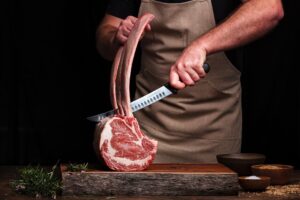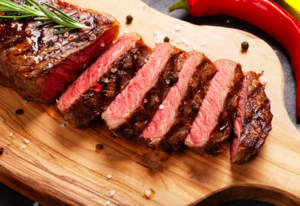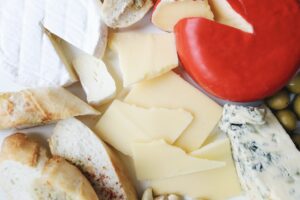Wagyu Beef can be called the finest and most luxurious beef in the world. It is incomparably tender and juicy with beautiful marbling. By reading this article, you will learn everything about Wagyu. Let’s dive in!
Table of Contents
◈ What is Wagyu Beef?
Literally, Wagyu means Japanese cattle, but in fact it doesn’t equal every Japanese beef. It is a specific term for four native breeds of Japanese cattle raised professionally and hence with the finest quality.
1. Japanese Black (黒毛和種 Kuroge Washu)

Japanese Black is the primary beef breed in the market which accounts for more than 90% of Wagyu. Ranchers from many Prefectures of Japan raise this breed since it is extraordinary in quality. It has fine and rich marbling which delivers a desirable buttery and tender texture.
2. Japanese Brown (赤毛和種 Akage Washu)
Japanese Brown is also known as “Akaushi” (Aka=red, ushi=cattle) and it is raised in Kumamoto and Kochi Prefectures. Contrarily, Japanese Brown is much leaner than Japanese Black. It has low fat content and a firm but fine mouthfeel. This makes it taste mild and healthy.
3. Japanese Shorthorn (日本短角和種 Nihon Tankaku Washu)
Japanese Shorthorn is mainly raised in the Tohoku Region. Its meat is also lean and has a subtly different flavor because of inosinic acid and glutamic acid. These are substances that give the mild but savory flavor to the meat.
4. Japanese Polled (無角和種 Mukaku Washu)
Japanese Polled is the breed produced by crossbreeding Aberdeen Angus from Scotland with indigenous Japanese Black. It is lean as well which leads to a chewy texture. And since it contains a great amount of amino acid, it tastes rich and distinctive. However, there are only several hundreds of Japanese Polled exist today.
◈ What Is So Special About Wagyu Beef?

Wagyu beef is one of the yummiest beef in the world since they contain a perfectly rich marbling.
Marbling is the white streaks and flecks of fat within the meat which has another name, intramuscular fat. It directly affects the tenderness, juiciness and flavor of the beef. Marbling fat has a lower melting temperature and coats the muscle fibers once it melts. Thus, resulting in a tender and flavorful beef that brimming with juices. In other words, the richer the marbling the better the quality, in most instances.
There is an universal standard—Beef Marbling Score (BMS) to indicate the marbling level of beef. For example, USDA Prime beef is approximately equal to BMS 4-5. And the A5 Japanese Wagyu beef (grade of highest quality) scores BMS 8-12! So you know how Wagyu beef is superior!
◈ Price of Wagyu Beef
The price of Wagyu Beef varies from grades, brands and where the cuts of meat are taken from the cattle. Grades and brands of Wagyu beef will be further explained later in this article.
Generally said, Wagyu Ribeye Steak is more expensive than Wagyu Sirloin Steak typically.
When it comes to brands, there is a big difference in price. A 14 oz A5 Kagoshima NY Strip Steak costs around $150 while 14 oz A5 Kobe Beef NY Strip could cost you a fortune with nearly $380!
► Read More: 20 Best Steak Cuts with Ranking (A Complete Guide to Know Your Cuts)
◈ Why Is Wagyu Beef So Expensive?
To achieve the best quality, the Wagyu cattle grow in a stress-free environment with thoughtful care and strict management.
In the first 7 months, the professional breeders will raise the Wagyu cattle and then sell them to fattening farms. They grow with the most attentive care, for instance, the breeders will comb their hair with a stiff brush and massage them regularly for the sake of facilitating blood circulation. The Wagyu cattle live stresslessly which ensure their meat is not tense and lead to tough texture owing to the increase of adrenaline.
The Wagyu cows mainly eat hay, grain and wheat with no growth promotants, steroids, hormones or drugs are added. Hence, it takes about 3 years for them to grow while normal beef only needs 15 months.

Every Japanese Wagyu cattle owns a birth certificate which certifies their pure bloodline, plus a 10 digits individual identification number. By this individual number, all the information about the cattle is recorded in the database including gender, class, the way of breeding and more. This makes everything traceable and guarantees the unified high quality of meat.
All these costly, considerate and strict quality control as well as the delightfully rich marbling make Wagyu beef so expensive.
◈ Is Wagyu Beef Healthy?
Wagyu Beef is full of protein. Apart from rich protein, according to a study published in 2016, Wagyu beef has a higher proportion of monounsaturated fat when compared to other red meats. It is a healthy fat that olive oil, avocado and fish contain a lot. It helps reduce the level of bad cholesterol and is beneficial to the cardiovascular system.
However, monounsaturated fat is also a kind of fat and do not eat without limitation.
► Read More: Grass Fed Beef vs Grain Fed Beef
◈ Top 3 Japanese Wagyu Brands
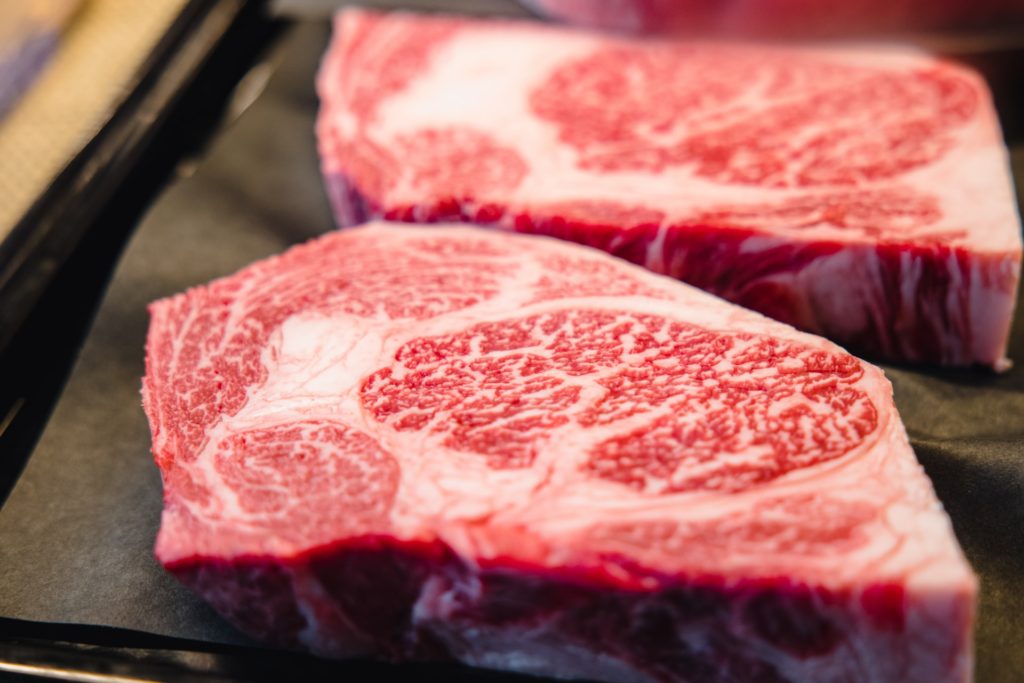
There are about 160 Japanese Wagyu beef brands and each of them has their own evaluation standard. The beef is evaluated according to the origin, bloodline, breed, meat quality and other factors. Only the beef meets the standards can be crowned with the brand name.
Among these hundreds of brands, the top three brands are the most highly favored—they are Matsusaka beef, Kobe beef, and Omi / Yonezawa beef. It is arguable whether it is Omi beef or Yonezawa beef, but I am sure that both of them are top-of-the-line!
1. Matsusaka Beef (松阪牛)
Matsusaka Beef is featured with a high fat-to-meat ratio and evenly distributed marbling.
The Wagyu cattle are strictly selected and raised with the best care. The breeders will feed the cattle with beer as well as massage them regularly in order to optimize the meat quality. Only the beef with grade 4 or above could get the label of Matsusaka Beef.
2. Kobe Beef (神戸ビーフ)
Kobe Beef is famous for tenderness and abundant marbling that is incredibly scrumptious. Also, the meat is excellently fine and smooth.
It is probably the most highly prized Wagyu which comes from the outstanding bloodline of Wagyu—Tajima (但馬). The melting point of the rich marbling is rather low and so will melt in your mouth with max umami after searing.
3. Omi Beef (近江牛)
Omi Beef is well-known for the fine and buttery texture.
Wagyu cattle grow in Shiga Prefecture where agriculture thrives due to nice weather and feeds. Hence, the meat quality is fabulous and it is also popular with French restaurants.
4. Yonezawa Beef (米沢牛)
The smooth and creamy texture of Yonezawa Beef is extraordinary.
It is the only brand originating from Northeastern Japan among these top 4 brands. The wonderful breeding environment, mineral-rich feed and the long-term fattening result in the first-rate quality. Only the cows with no production, fattening time more than 32 months, and A3 or higher grades could receive this prestigious label.
Many people ask for the comparison of “Wagyu vs Kobe beef”. And now you know, Kobe beef is a kind of Wagyu beef, so we could not compare them directly.
Other than these brands, Miyazaki Beef, Hida Beef, Kagoshima Beef, Hokkaido Wagyu, Saga Beef and Olive Wagyu are also awesome!
► Read More: What is Olive Wagyu? What So Special? Where to Buy? | The Rarest Beef
◈ What is American / Australian Wagyu Beef?
As mentioned previously, Wagyu refers to Japanese beef. So how come American and Australian Wagyu beef? Actually, they are crossbreeds which are the products of purebred Japanese Wagyu and American or Australian cattle breeds.
Thanks to the exceptional genes of Japanese Wagyu, the amount of marbling of the crossbreeds is taken to a whole new level, thereby even more desirable.
◈ Wagyu Grading Systems
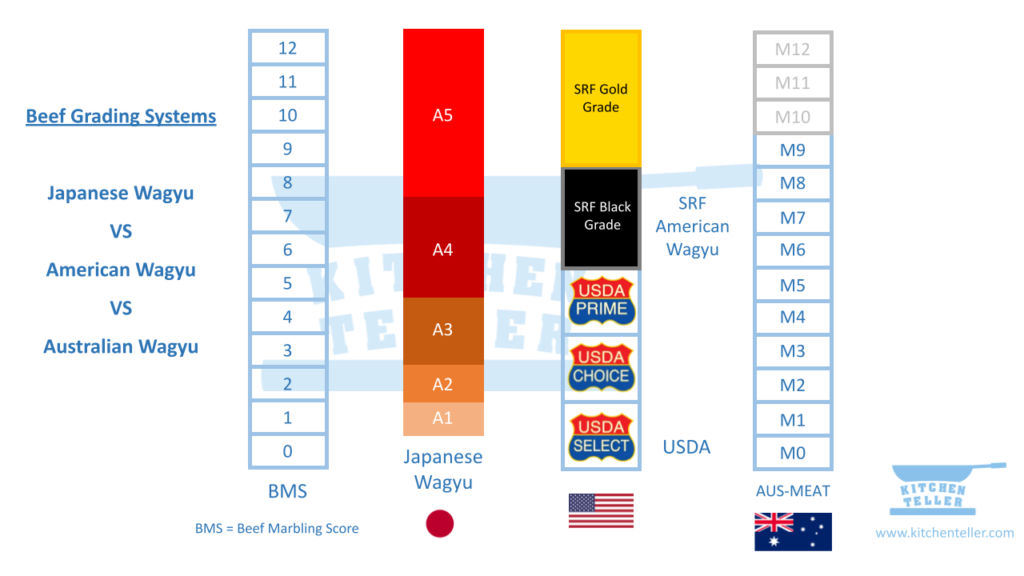
A. Japanese Wagyu Grading

“A5 Wagyu” is an attractive term but do you really know what “A5” means?
It is the finest grade of Japanese Wagyu beef and the grading system is managed by the Japanese Meat Grading Association (JMGA). They grade beef by two aspects, Yield Grade (represented by a letter from A to C) and Meat Quality Score (represented by a number from 1 to 5). And finally combine them into an overall grade.
Yield Grade is about the percentage of edible meat of the Wagyu carcasses apart from internal organs and skin. “A” stands for the highest yield grade and C represents the lowest. Only fullblood Wagyu can get an A.
Meat Quality Score measures (1) meat marbling; (2) meat color and brightness; (3) meat firmness and texture; (4) fat color, luster and quality. Each factor ranges from 1 to 5 scores, the higher score stands for the better quality. After assessing, the final meat quality score depends on the lowest score among these four factors. For example, a beef scores 5 in three factors but only gets 3 scores in marbling, the final Meat Quality Score of this beef is 3 only.
In short, there are altogether 15 grades of Japanese Wagyu beef while the top-notch “A5” is very rare. That is to say, the beef has to get full marks in all aspects. That’s why A5 Wagyu is amazingly unrivaled and luxurious.
B. American Wagyu Beef Grading
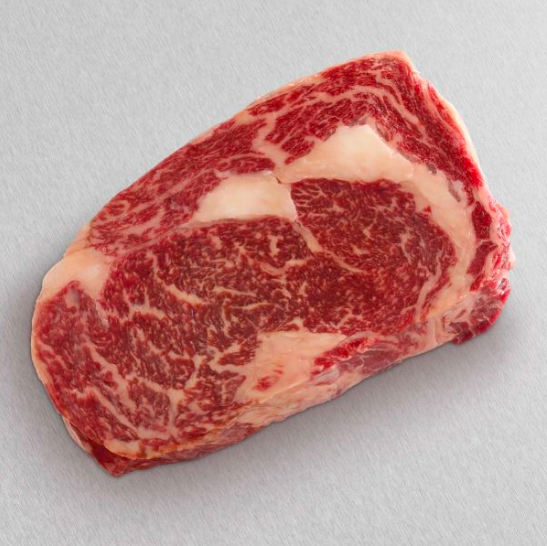
The amount of marbling of American Wagyu beef is richer than the USDA grading system could cover. Therefore, the pioneer of American Wagyu, Snake River Farms, classify their beef as Gold Grade and Black Grade.
SRF Gold Grade—It has a rich marbling that scores BMS 9+. The level of marbling is equivalent to A5 Japanese Wagyu beef. It tastes unbelievably delicious that melts like butter on your tongue.
SRF Black Grade—Beef in this grade possesses a wealth of marbling and gorgeous tenderness as well as juiciness. The meat scores BMS 6-8 which is about A4-5.
C. Australian Wagyu Beef Grading
Australian Wagyu beef is graded the same as ordinary Australian beef by a system called AUS-MEAT grading.
The AUS-MEAT focuses on marbling and scales from M0 to M9 in increments of 1. However, the marbling content of Australian Wagyu goes beyond M9. Consequently, the beef sellers created the grades M10, M11 and M12 by themselves.
► For a more detailed guide of beef grading, Click Here.
◈ How to Cook Wagyu Beef? 5 Best Ways To Prepare!
After diving into the knowledge of Wagyu beef, you are ready to order one. Here comes an important question: how to cook Wagyu beef? There are hundreds of ways to cook Wagyu beef and it mainly depends on what cut it is and your preference.
► How to Thaw Wagyu Beef Properly?
This is the first question before starting cooking. It’s easy, transfer the beef from the freezer to the refrigerator 8 hours before cooking. Do not rinse it with water, otherwise you will waste the precious beef!
1. Wagyu Steak
Steak is the most common way of enjoying Wagyu beef in America. It is the best way to taste the excellent texture of Wagyu directly. The premium cuts like Ribeye, Filet Mignon and New York Strip Steak are very suitable to cook as steak.
Similar to ordinary steaks, sear the Wagyu steak in a cast iron pan over high heat with simple seasonings. Yet, Wagyu with good grades have a great amount of fat and so don’t add too much oil or butter (sometimes even don’t need any). Also, the needed heating time is shorter than that of ordinary beef. This is because the melted fat will speed up the color change of beef and lead to a not beautiful appearance.
The best doneness is medium but precisely, it varies with the steak cuts. I would recommend medium rare for Filet Mignon.
Letting the steak rest after searing is a widely known tip to push the meat to the next level. It allows the residual temperature to continue to heat the interior and let the juices redistribute evenly. Hence, the juices are retained and the steak tastes very juicy. But the tip is different when it comes to Wagyu steak. Since Wagyu cattle have fewer blood vessels and thus the meat will not lose too much juices. Therefore, the time of resting a Wagyu steak is shorter than that of regular steak. 5 minutes for a normal cut and 10-15 minutes for a thick cut.
2. Yakiniku (Japanese BBQ)

Yakiniku means grilled meat in Japanese which is probably the most popular way to enjoy Wagyu beef in Japan. The Wagyu beef for yakiniku is thinly sliced and grilled on gas or charcoal. Because the Wagyu beef has plentiful marbling, the grill is easy to catch fire. Remember to change the position when it catches fire to avoid overcooking.
3. Sukiyaki
What Is Sukiyaki?
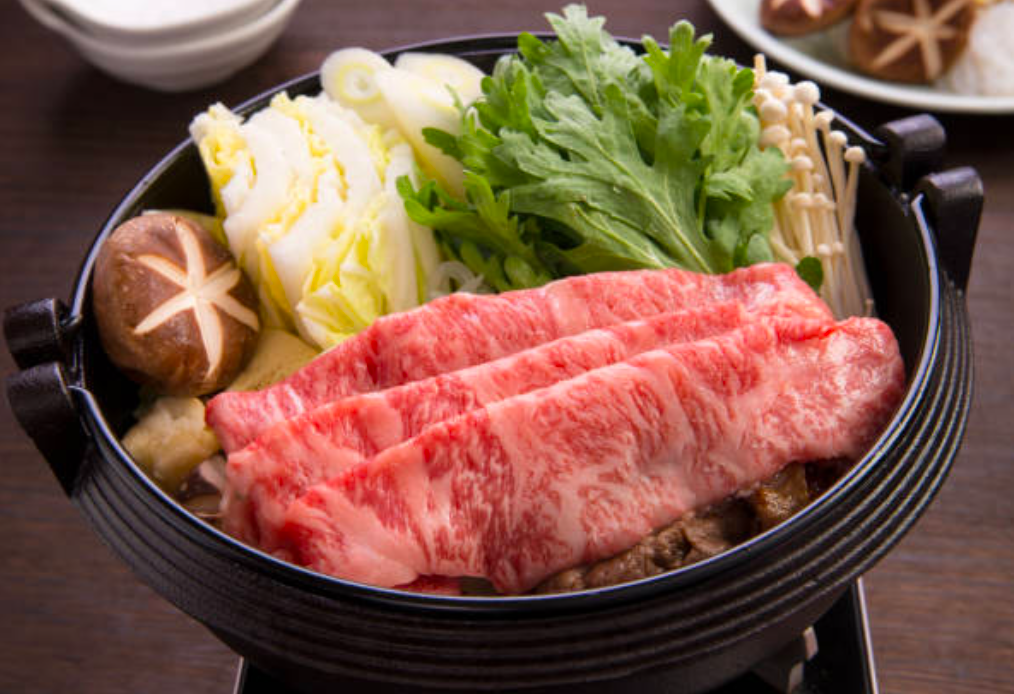
Sukiyaki is a Japanese dish that cooks foods with a small amount of broth mixture in a shallow iron pot. It is a kind of nabemono, which means a variety of Japanese hot pot dishes or one pot dishes.
The styles vary from the regions of Japan but the primary components are more or less the same. The major food items are thinly sliced beef, tofu, negi, vegetables, mushrooms and konnyaku noodles. And the broth mixture is mainly made of soy sauce, sake, sugar, mirin and dashi. After simmering the beef slices in the mixture, dip the beef into a small bowl of raw, beaten eggs. It tastes amazingly delicious with a sweet flavor.
Here is a recipe for 4 servings:
Ingredients
- Wagyu Beef Slices—600 g
- Shiitake Mushroom—4 oz
- Enoki Mushroom—4 oz
- Tofu—12 oz
- Vegetables such as Chinese cabbage—some
- Konnyaku Noodles—200 g
- Udon—4 servings
(Broth mixture)
- Onion—1 medium size
- Negi—1 bunch
- Soy Sauce—100 ml
- Sake—100 ml
- Mirin—100 ml
- Dashi or Water—150 ml
- Sugar—2 tablespoon
(Dipping sauce)
- Japanese eggs
Steps By Step Guide
- Wash and prepare all the ingredients well.
- Fry the sliced onion in a shallow iron pot over medium heat until the onion becomes brown which means caramelization occurs. Add chopped negi and stir for a while.
- Pour the Mirin and Sake until boiling, reduce heat to low. Add soy sauce, sugar and dashi. Mix well.
- Beat a raw egg in a small bowl as dipping sauce.
- Simmer the ingredients you like and enjoy!
Cooking Tips
- Just a few seconds is enough to simmer the beef as it is thin. Don’t overcook!
- In step 3, do not pour too much as the feature of sukiyaki is simmering foods in a small amount of broth. Add the remaining when the mixture level is low.
- After digging in for a while, the mixture will be more concentrated. I suggest adding some water but not dashi since it is too strong at that moment.
- The yummiest udon noodles are added after simmering beef. At that time, the broth mixture will be rich with fat essence and deliver an extra kick.
4. Shabu-shabu (Japanese Hot Pot)
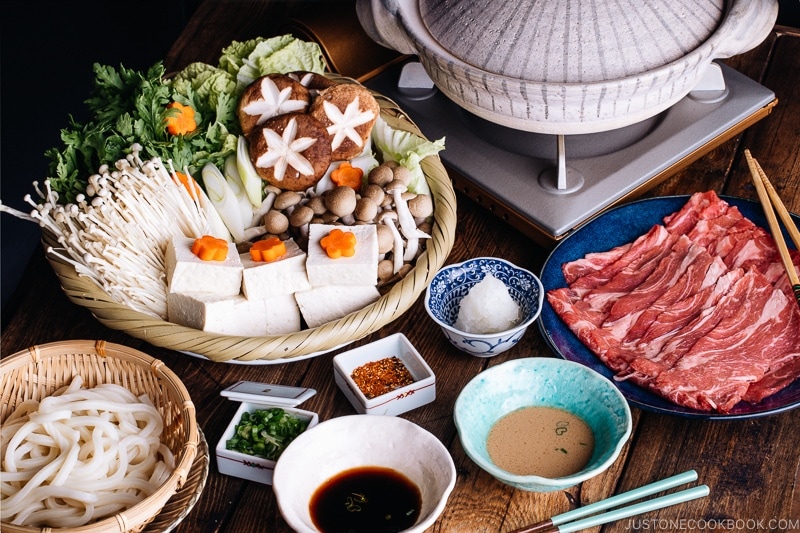
Shabu-shabu is also a kind of nabemono but the broth and dipping sauce are different from sukiyaki. The flavor of shabu-shabu is more savory, less sweet and milder than sukiyaki. It could highlight the original taste and umami flavor of Wagyu beef slices.
Likewise, you can add any foods you like to boil in the broth. The following is an easy recipe for the broth of shabu-shabu:
Ingredients of Broth
- Konbu—10 g
- Katsuobushi Flakes—20 g
- Water—800 ml
Steps By Step Guide
- Add water to a pot.
- Soak the konbu in the pot, place it in the refrigerator overnight.
- On the next day, boil with low heat for 10 minutes, then turn to high heat.
- When it starts bubbling, take out the konbu. Otherwise, the konbu will release something slimy and make it unclear.
- Add katsuobushi flakes and boil for 2 minutes. Turn off the heat.
- Filter with nets and done! Boil the ingredients you love such as Chinese cabbages, tofu and Wagyu beef slices.
Cooking Tips
- Just boil the beef slices for a few seconds since it is thin. Ideally, the beef is still pink. Don’t overcook!
- The white stuff on dried konbu is normal. Wipe with a wet paper napkin.
5. Wagyu Sushi
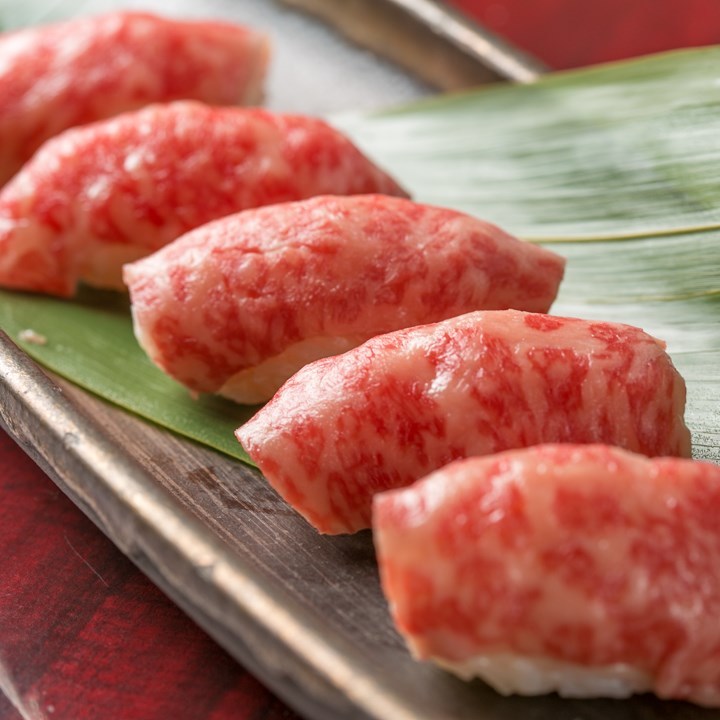
Use A4 or above Wagyu beef for sushi which has evenly distributed marbling and fine texture. The beef slices could be raw or flamed, both are palatable! You can do it at home easily as well.
Step by Step Guide
- Thaw the Wagyu beef slices properly.
- Cook rice. Add 25-30 ml rice vinegar to a bowl of rice (about 170 g) and mix well.
- Rest it for 10 minutes.
- Dip a little bit of water on the hands to prevent the rice from sticking. Form a rectangular shape of rice (20-25 g each)
- Top with Wagyu beef slices.
- (Optional) Flame the beef by using a searing torch for a few seconds to melt the marbling.
- Dip with soy sauce and enjoy!
Cooking Tips
- When forming the rice, do not press too tight which will destroy the mouthfeel of rice.
- It is an artisanal job, if you are not good at handwork, eat in a restaurant!
Summary
Wagyu Beef is as exquisite as fine wine, and the price is daunting too. But you must pay out to taste the best. To compromise, opt for some lesser-known Wagyu brands besides the top three brands, which are also scrumptious but relatively budget-friendly.
► Read More: 8 Primal Cuts of Beef to Learn Before Ordering Steaks


